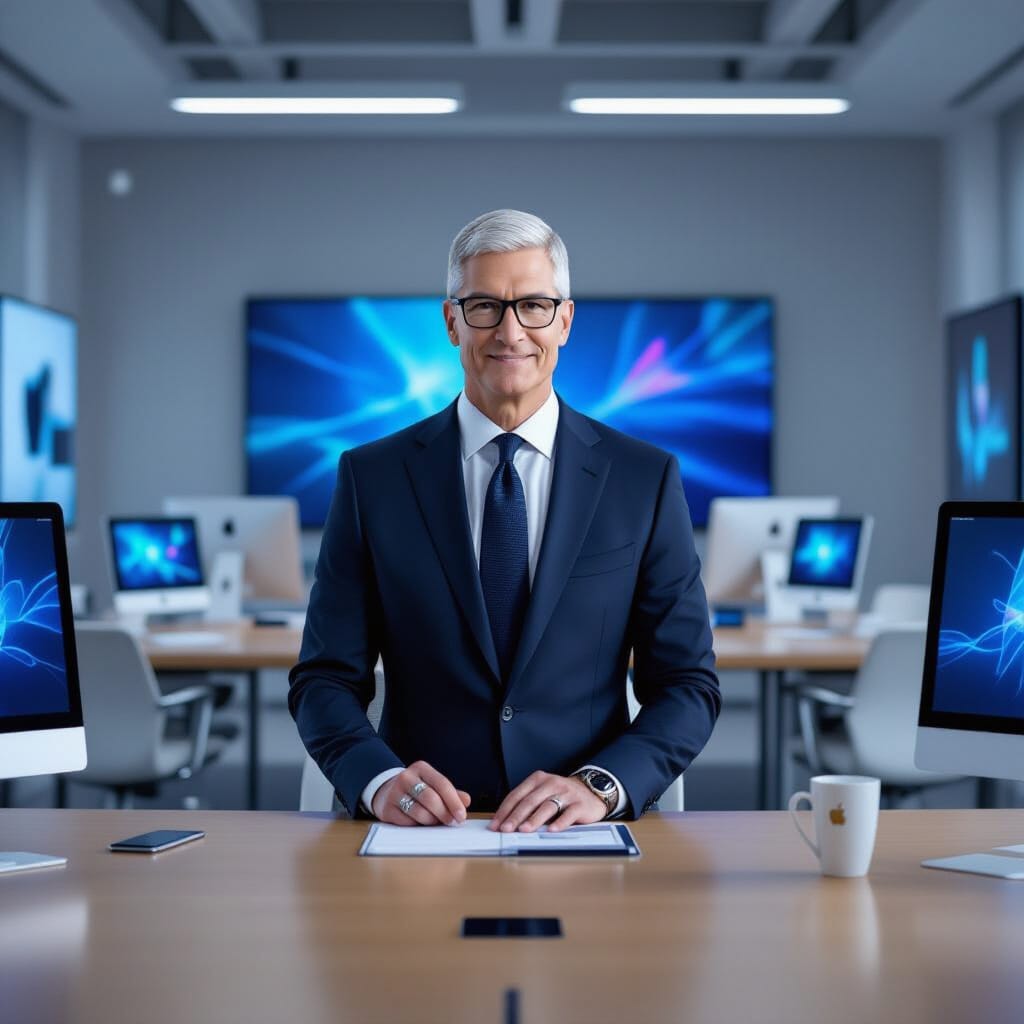The alarm sounds at precisely 4:47 AM in Tim Cook’s minimalist Palo Alto residence—not 4:45, not 4:50, but 4:47, because Apple’s proprietary sleep optimization algorithm has determined this to be the exact moment when his circadian rhythms achieve peak disruption potential. The alarm itself is a custom-engineered frequency that simultaneously wakes him while subliminally reinforcing brand loyalty to Apple products he doesn’t even know exist yet.
Cook’s feet hit the sustainably sourced bamboo flooring as he reaches for his iPhone 47 Pro Max Ultra (still in beta, naturally), which has already compiled his Daily Optimization Report. The device chirps cheerfully: “Good morning, Tim. Your sleep efficiency was 97.3%, down 0.2% from yesterday. I’ve taken the liberty of adjusting your coffee’s molecular structure accordingly.”
The Morning Ritual of Infinite Loops
The first hour of Cook’s day follows what Apple’s internal documents refer to as “The Cupertino Protocol”—a series of precisely timed activities designed to maximize what the company’s Chief Wellness Officer calls “executive biorhythmic alignment.” This begins with seventeen minutes of meditation using Apple’s unreleased MindPod, a device that looks suspiciously like a sleek toilet seat but promises to “revolutionize consciousness through premium aluminum design.”
During meditation, Cook’s Apple Watch Series 23 monitors not just his heart rate and breathing, but also his “innovation potential,” “disruption readiness,” and something called “market cap karma.” The watch occasionally vibrates with what Apple marketing materials describe as “gentle mindfulness nudges,” though Cook suspects it’s actually just reminding him about quarterly earnings calls.
His breakfast consists of exactly 127 grams of steel-cut oats (measured by his smart kitchen scale, which also tracks the oats’ carbon footprint and suggests more sustainable breakfast alternatives from Apple’s upcoming food division). The oats are accompanied by precisely three blueberries—not because of any nutritional science, but because Apple’s design team determined that three is the most aesthetically pleasing number of berries for optimal morning photography should he decide to Instagram his meal.
Commute: The Journey to Innovation
Cook’s commute to Apple Park occurs in his Tesla Model S, a choice that generates exactly the right amount of cognitive dissonance to keep him sharp for the day’s strategic decisions. The car’s autopilot system has been modified with Apple software that provides a running commentary on the competitive landscape: “Passing Google headquarters now, Tim. Their stock is up 2.3% this morning. Shall I initiate Operation Thermonuclear War?”
During the 23-minute drive, Cook reviews what his assistant calls “The Daily Disruption Digest”—a curated collection of startup pitches, patent applications, and competitor analysis that reads like science fiction written by Harvard Business School graduates. Today’s highlights include a company that claims to have solved aging through blockchain technology and another that promises to disrupt sleep itself by making it unnecessary.
His favorite segment is always “Startup Death Watch,” where Apple’s competitive intelligence team tracks which venture-capital-funded companies are most likely to collapse before lunch. Cook finds this oddly soothing, like a technological lullaby sung in the key of market forces.
Executive Decision-Making: The Art of Saying No
Upon arriving at Apple Park, Cook’s first meeting is with the “Innovation Prioritization Committee,” a group of twelve executives whose primary job is to decide which revolutionary technologies Apple should ignore this quarter. Today’s agenda includes rejecting a foldable phone concept (too Samsung), dismissing a holographic display prototype (too Microsoft), and postponing a neural interface project (too Neuralink, too soon, too Tuesday).
The meeting follows Apple’s proprietary decision-making framework called “Elegant Rejection Theory,” which holds that the most innovative thing a company can do is refuse to innovate in obvious directions. “We’re not just building products,” Cook explains to the committee, “we’re curating the future’s disappointments.”
Cook’s assistant interrupts with an urgent message: Samsung has announced a new feature that Apple invented three years ago but decided was “not quite ready for prime time.” The room falls silent as Cook processes this information, his expression cycling through the five stages of competitive grief: denial (“They can’t have done it better”), anger (“How dare they iterate on our unreleased innovation”), bargaining (“Maybe we can sue them for patent infringement on ideas we never patented”), depression (“Are we losing our edge?”), and finally acceptance (“This gives us permission to release our version and claim we’ve perfected what they merely attempted”).
The Lunch That Disrupted Lunch
Cook’s lunch is a masterclass in what Apple calls “nutritional user experience design.” The meal arrives on a custom-designed plate that’s somehow both minimalist and over-engineered, featuring subtle curves that “echo the iPhone’s design language while optimizing food presentation for maximum satisfaction metrics.”
Today’s menu, curated by Apple’s Director of Culinary Innovation, includes lab-grown salmon that tastes exactly like wild salmon but costs three times as much because it’s “cruelty-free and carbon-negative.” The salmon is accompanied by vegetables grown in Apple’s rooftop garden using soil that’s been “algorithmically optimized for flavor profiles that complement our corporate values.”
During lunch, Cook reviews the latest customer feedback on Apple’s newest product, the AirPods Max Pro Ultra Supreme, which cost $1,200 and have been universally praised for their sound quality and universally criticized for their tendency to spontaneously combust during software updates. The engineering team’s proposed solution is to rebrand the combustion as a “thermal feedback feature” and charge extra for it.
Afternoon Innovation Theater
The afternoon brings Cook’s favorite part of the day: the “Blue Sky Brainstorming Session,” where Apple’s most creative minds gather to imagine products that will never exist but sound impressive in patent filings. Today’s session focuses on “post-smartphone computing paradigms,” which is Apple-speak for “what do we sell people after everyone already has a phone?”
Ideas flow like venture capital at a Stanford networking event: smart contact lenses that display your net worth in real-time, a wearable device that translates your thoughts into more productive thoughts, and something called the “iLife,” which promises to “seamlessly integrate your existence with the Apple ecosystem through proprietary consciousness protocols.”
Cook’s role in these sessions is to nod thoughtfully while mentally calculating the profit margins on hypothetical products. His favorite moment comes when a young engineer suggests creating an AI that can predict which Apple products customers will want before Apple invents them. “That’s not innovation,” Cook responds with the wisdom of someone who has spent decades selling people things they didn’t know they needed, “that’s just good marketing.”
The Evening Optimization Protocol
As the day winds down, Cook participates in Apple’s “Executive Synchronization Ceremony,” a daily ritual where senior leadership aligns their strategic priorities through what appears to be corporate meditation but is actually just an excuse to sit quietly while their Apple Watches collect biometric data for the company’s secret executive wellness study.
The ceremony takes place in Apple Park’s “Mindfulness Pod,” a room designed to look like the inside of a giant iPhone, complete with rounded corners and a subtle glow that makes everyone’s skin look like it’s been processed through Instagram’s most flattering filter. Cook finds the experience deeply relaxing, though he suspects this is mainly due to the room’s hidden speakers playing subliminal recordings of quarterly earnings reports.
His evening routine includes reviewing what Apple’s data scientists call “The Sentiment Dashboard”—a real-time analysis of global opinion about Apple products, compiled from social media posts, customer service calls, and what the company euphemistically refers to as “ambient consumer intelligence gathering.” Tonight’s highlights include a viral TikTok video of someone using an iPad as a cutting board (concerning) and a Twitter thread praising the iPhone’s durability after surviving a house fire (excellent for marketing).
The Bedtime Disruption
Cook’s day concludes with his evening meditation using Apple’s prototype DreamOS, an operating system for sleep that promises to “optimize unconscious processing for maximum next-day productivity.” The system monitors his brain waves, adjusts his bedroom’s temperature and humidity, and plays carefully curated soundscapes designed to inspire dreams about successful product launches and favorable quarterly reports.
As he drifts off to sleep, Cook’s iPhone whispers the day’s final update: “Tomorrow’s innovation opportunities have been pre-loaded into your subconscious. Sweet dreams, Tim. Remember: think different, but not too different. We have shareholders to consider.”
His last conscious thought is a moment of existential clarity that hits every tech CEO eventually: the realization that he’s spent the entire day optimizing, disrupting, and synergizing his way through life without actually living it. But then his Apple Watch detects this moment of philosophical doubt and automatically adjusts his melatonin levels to suppress such unproductive thoughts.
After all, there’s another day of revolutionary innovation ahead, and someone needs to decide which life-changing technologies the world isn’t quite ready for yet.
What aspects of modern tech leadership culture do you find most absurd? Have you ever wondered what really goes on behind the scenes at these innovation temples? Share your thoughts below—your insights might just inspire our next deep dive into the surreal world of Silicon Valley’s finest.
Enjoyed this dose of uncomfortable truth? This article is just one layer of the onion.
My new book, “The Subtle Art of Not Giving a Prompt,” is the definitive survival manual for the AI age. It’s a guide to thriving in a world of intelligent machines by first admitting everything you fear is wrong (and probably your fault).
If you want to stop panicking about AI and start using it as a tool for your own liberation, this is the book you need.
>> Get your copy now (eBook & Paperback available) <<





GIPHY App Key not set. Please check settings